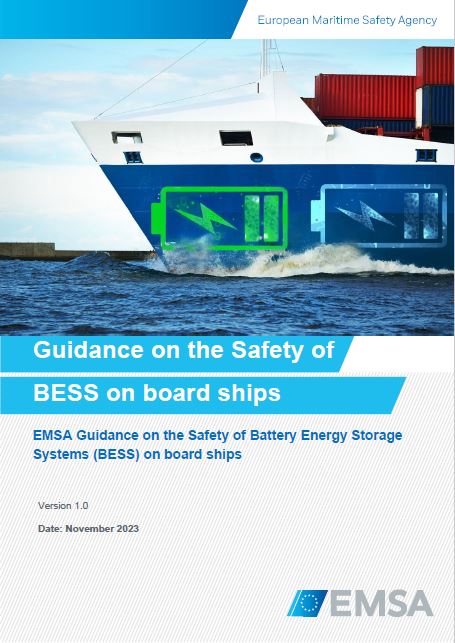Electrification

Safety Guidance on battery energy storage systems
The European Green Deal and the IMO initial and up-coming mid- and long-term Strategies for Greenhouse Gas (GHG) reduction have sparked the development and implementation of technical solutions aiming at reducing GHG emissions from shipping.
The use of alternative zero carbon and sustainable fuels is increasing, as are solutions based on electrification. A number of these options are already available in the market, ranging from pure electric to hybrid-electric and hybrid plug-in shipping models.
Electrification brings advantages for the sector not only in terms of sustainability, by reducing emissions and energy consumption, but also in design and operations, reducing maintenance and allowing for more flexibility in the powertrain arrangements on board.
BESS installations: a growing trend
Battery Energy Storage Systems (BESS) installations on board ships have been increasing in number and installed power as the battery technology also develops. According to the Alternative Fuels Insight platform, there are more than 800 battery ships in operation, a figure that has more than tripled in the past five years. Out of those, around 60% are known to be operating in Europe, using batteries on board for propulsion either in pure electric or hybrid functions. At least 50% are hybrid or plug-in hybrid, and around 13% are pure electric.
The current low energy density of the available energy storage systems makes them a preferred option for short-distance voyages or services that require low-autonomy. For this reason, the largest number of installations are in car and passenger ferries and ships dedicated to activities other than deep-sea commercial cargo transport.
EMSA supporting Member States and industry
Rapid technological development requires the implementation of technologies being made in a safe and uniform way across the sector based on well understood, simple and solid safety guidance. Currently, there is no regulatory instrument at international level on the safety aspects of using batteries in ships. This important scope has been left to, and evolved through, the requirements of class, industry standards, and codes, with limited requirements and experience from the side of flag states.
EMSA, with the support of the European Commission, the Member States and industry, has drawn-up this non-mandatory Guidance to guide national administrations and industry, and which aims for a uniform implementation of the essential safety requirements for battery energy storage systems on board of ships.
The development of the Guidance was supported by an extensive Group of Experts, who brought essential knowledge on the requirements of classification societies, industry standards and available research.
The scope of the Guidance is limited to lithium-ion batteries due to their prevalent uptake in the industry. With respect to traditional technologies, there is a change in the risk profile of this type of batteries mainly due to fire and explosion caused by the thermal runaway and off-gas generation. Based on available literature shared by the group of experts, and previous EMSA studies, functional requirements were developed, using li-ion technology as reference, to mitigate the risks of these systems at the design, installation, and operation stages.

The Guidance addresses the hazards and measures to reduce the risks of Battery Energy Storage Systems (BESS) when installed on board ships, providing guidance on their design, installation, testing, operation, maintenance, and the training of those who manage their operation. This Guidance, aims at supporting a uniform assessment of the safety level of these installations by the Administrations in coherence with the safety goals in the International Conventions and the applicable EU legislation.
The shore-side dimension
Operation of electric power-driven ships requires shore-side infrastructure, not only for a supply of shore power but also for charging secondary battery groups onboard. Interconnectivity and interoperability are key challenges to address for shore-side electricity connection.
From a safety perspective, two sides of the problem need to be analysed: on the one hand, the safety risks due to the installation of high-capacity batteries onboard ships; and, on the other, the risks coming from the interface between onshore charging stations and the ship itself. As a result, EMSA has published its Guidance on Shore-Side Electricity, which is intended to assist in the planning and development of shore-side electricity options, and which is addressed to port authorities and administrations.
